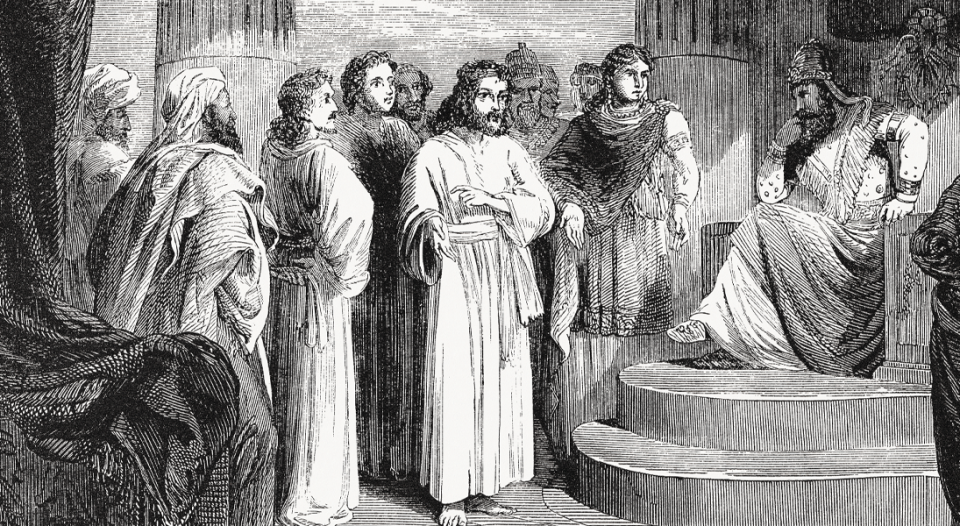Series editor’s note: Throughout 2023, “Deeper understandings” will feature biblical scholars reflecting on one of the books of the Old Testament. Kristin Wendland will continue this theme in the May-June issue. —Kathryn A. Kleinhans, dean of Trinity Lutheran Seminary at Capital University, Columbus, Ohio, on behalf of the ELCA’s seminaries
In my seminary classroom I sometimes talk about the “Malachi-to-Matthew problem.” This is the problem of turning the page from Malachi (in many Christian Bibles, the last book of the Old Testament) to Matthew (the first book of the New Testament) and feeling as if we’re entering a different theological world.
When we’re used to reading about Canaanites and Babylonians, we might be surprised to discover that suddenly, in the Gospels, there are Romans everywhere. We learn also that the universe is populated by demons who cause mischief in people’s bodies, and that someone called “the devil” is somehow connected to them.
Further, among God’s people, the Jews, there are ongoing debates about a resurrection on a last day and unexplained references to a “son of man” and a “desolating sacrilege.” Jesus and his contemporaries talk about such familiar figures as Moses, David and the prophets but with a new emphasis on their legacies as writers and keepers of important books.
In the New Testament we learn that the universe is populated by demons and that someone called “the devil” is connected to them.
These novelties are presented in the New Testament as if we should already be familiar with them, so a Bible reader who started at Genesis 1 can be forgiven for feeling like a Star Wars fan at a Star Trek convention.
We’re not stepping into a new universe, though—we’re skipping from Act 1 of a play to Act 3. Many Bible scholars refer to the missing Act 2 as the “Second Temple” period, which began at the end of the sixth century B.C.E. when a group of Judeans/Jews returned to Jerusalem from exile in Babylon, formed a society and rebuilt the temple.
During the Second Temple period, Jews continued to spread out across the ancient world in an interconnected diaspora. The Roman destruction of Jerusalem in 70 C.E. marks the traditional end of the period, which means that the life of Jesus and the most important events depicted in the New Testament occurred during this time.
Lacking in spirituality
To be clear, the Malachi-to-Matthew problem has been perpetuated as much by how we read the Bible as it is by how our Bible happens to be printed. Thus, even if your Bible includes the so-called Apocrypha or Deuterocanonical books (a collection of Jewish writings largely originating from the Second Temple period), this problem can persist.
This is due, in part, to the fact that some of the most influential Bible scholars of the 19th and early 20th centuries denigrated the Second Temple period as lacking in spirituality and theological creativity. (You may have heard it referred to as the “intertestamental” period.) More recent scholarship has rejected these anti-Semitic and anti-Jewish claims and rightfully recognized the Second Temple period as a rich time of literary production that shaped the world in which Jesus and his earliest followers lived.
This is where the book of Daniel comes in. Bible scholars continue to debate the dating and developmental history of various parts of the Old Testament, yet the book of Daniel is an unambiguous product of Second Temple Judaism, helping us bridge the gap between Malachi and Matthew.
In Christian theology, there is no “God of the Old Testament” versus a “God of the New Testament.”
In Daniel we find the imagery of the son of man (7:13) and a world in which angels and their opponents actively intervene in human affairs (10:10-14). The book contains a key witness to pre-Christian Jewish thought about resurrection (12:1-4).
Daniel also gives us an early example of the Bible citing and interpreting itself. Daniel 9:1-2 and 9:20-27, for example, use a creative method of interpretation to understand a prophecy in Jeremiah. This method has similarities to later midrash (a common form of Jewish exegesis from antiquity to the Middle Ages) and is also represented in the New Testament. To be clear, the form of Judaism we see in Daniel is not the same as what Jews practice today. Rather, both Christianity and Rabbinic Judaism should be seen as having their roots in the Second Temple period.
Recognizing the book of Daniel as a bridge between Malachi and Matthew isn’t just a helpful strategy for Bible geeks and historians. In our era of rising anti-Judaism and anti-Semitic violence, emphasizing the Second Temple roots of our Christian faith is an ethical imperative. In Christian theology, there is no “God of the Old Testament” versus a “God of the New Testament”—there is only one God. To deny that confession is to flirt with the dangerous idea that Jews and Judaism are a problem to be solved by Christianity. The book of Daniel helps us appreciate how Jewish the early Jesus movement really was. In turn we can celebrate the promise that, through Christ, Gentiles are welcomed into God’s story with Israel.





